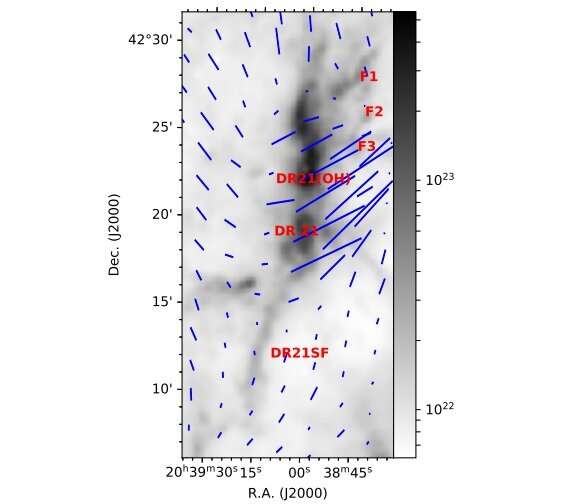The column density of the DR 21 area is shown by gray scale. The orientation of the blue segments indicates the orientation of the the magnetic field traced by polarized dust emission and length of the segments indicates the relative fraction of polarization. Credit: Hu et al., 2020.
Using the Shanghai 65-m TianMa Radio Telescope (TMRT), Chinese astronomers have investigated a gas filaments of the Cygnus X molecular cloud complex known as DR21SF. Results of the new study, presented in a paper published December 4, shed more light on the properties of this unique structure.
At a distance of some 4,600 light years away, Cygnus X is one of the closest giant molecular cloud complexes and a region of ongoing high-mass star formation. Its most massive and star-forming active filament is known as the DR 21 ridge and observations show that it consists of two filamentary structures.
In a recent study, a team of astronomers led by Bo Hu of the Nanjing University, China, have reported on observations of the more prominent structure of this ridge designated DR 21 South Filament (DR21SF). They employed TMRT to get more information about the nature of this filamentary structure.
"In order to understand the nature of DR21SF and its relationship with the DR 21, we perform spectral line observations of NH3 toward the filament, which will be analyzed in conjunction with our existing column density map of the filament derived from the Herschel data," the astronomers wrote in the paper.
The observations found that DR21SF has an estimated size of 11.7 by 0.42 light years and a mass of about 1,048 solar masses. Several low and intermediate mass young stellar objects (YSOs) were identified in the filament, with one candidate star forming core in its extremely early evolutionary stage.
According to the study, the filament has an average temperature at a level of 10-15 K, typical of cold molecular clouds, but the sites of low-/intermediate-mass YSOs show temperature excess. No signatures of fragmentation have been observed in DR21SF, and the astronomers assume that it may be due to the early evolutionary stage or the unique external gravitational field produced by DR 21.
The research also detected a radial velocity gradient of about 0.8 km/s/pc, along the spine of DR21SF. They scientists interpret this gradient as an accelerating gas flow in DR21SF towards DR 21, with a mass transfer rate of approximately 0.0011 solar masses per year.
Taking into account all the results, the authors of the paper concluded that DR 21, the source of the most energetic outflow in the Milky Way, may have a major mass supply from a parsec-scale accretion flow. "Since there is no detected gas flow towards DR 21 along the DR21 ridge, the gas in-fall along the DR21SF is possibly the most important, if not only, accretion flow that is feeding DR 21 massive star forming region," the researchers explain.
Moreover, the data suggest that DR21SF is in an overall trans-critical status, which indicates an early evolutionary stage. However, high-resolution observations of the dust polarization towards this filament should be conducted in order to confirm this assumption.
More information: DR 21 South Filament: a Parsec-sized Dense Gas Accretion Flow onto the DR 21 Massive Young Cluster, arXiv:2012.02648 [astro-ph.GA] arxiv.org/abs/2012.02648
© 2020 Science X Network
























